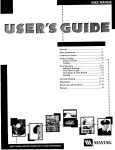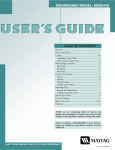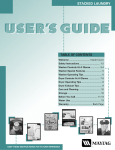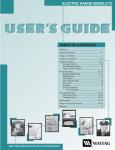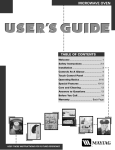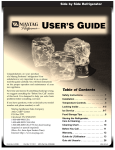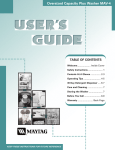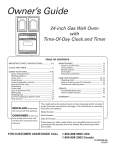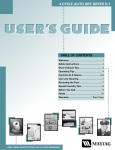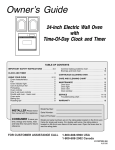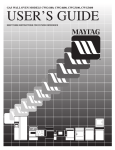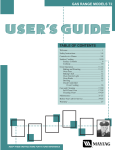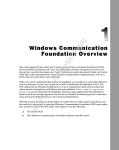Download Maytag MGR4450B User`s guide
Transcript
○ ○ ○ ○ ○ ○ ○ ○ ○ ○ ○ ○ ○ ○ ○ ○ ○ ○ ○ ○ ○ ○ ○ ○ ○ ○ ○ GAS RANGE WT TABLE OF CONTENTS ○ ○ ○ ○ ○ ○ ○ ○ ○ ○ ○ ○ ○ ○ Care and Cleaning ........................................... 10-11 Maintenance .................................................... 12-13 Before You Call for Service ............................. 13-14 Warranty ............................................................... 15 ○ ○ ○ ○ ○ ○ ○ ○ ○ ○ ○ ○ ○ ○ ○ ○ ○ ○ ○ ○ ○ ○ ○ ○ ○ ○ ○ ○ ○ ○ ○ ○ ○ ○ ○ ○ ○ ○ ○ ○ ○ ○ ○ ○ ○ ○ Welcome ................................................................. 1 Safety Instructions ............................................... 1-4 Controls at a Glance ............................................... 5 Surface Cooking .................................................. 6-7○ Surface Controls ............................................... 6 Cooktop ............................................................ 7 Oven Operation ................................................... 8-9 Baking & Roasting ........................................... 8 Broiling ............................................................ 8 Oven Racks & Oven Bottom ........................... 9 Oven Vent & Light ........................................... 9 ○ ○ ○ ○ ○ ○ ○ ○ ○ ○ ○ ○ ○ ○ ○ ○ ○ ○ ○ ○ ○ ○ ○ ○ ○ ○ ○ ○ ○ ○ ○ ○ ○ ○ ○ ○ ○ ○ ○ ○ ○ ○ ○ ○ ○ ○ ○ ○ ○ ○ ○ ○ ○ ○ ○ ○ ○ ○ ○ ○ KEEP THESE INSTRUCTIONS FOR FUTURE REFERENCE ® Models: MGR4410B • MGR4450B Welcome ○ ○ ○ ○ ○ ○ ○ ○ ○ ○ ○ ○ ○ ○ ○ ○ ○ ○ ○ ○ ○ IMPORTANT SAFETY Congratulations on your choice of a Maytag gas range. Your INSTRUCTIONS ○ ○ ○ ○ ○ ○ ○ ○ ○ ○ ○ ○ ○ complete satisfaction is very important to us. Read and follow all instructions before using this appliance to prevent the potential risk of fire, electric shock, personal injury or damage to the appliance as a result of improper usage of the appliance. Read this user’s guide carefully. It is intended to help you operate and maintain your new range. In addition, you will find a booklet entitled “Cooking Made Simple.” It contains information on selecting cookware and provides baking, roasting and broiling tips. WARNING: If the information in this manual is not followed exactly, a fire or explosion may result causing property damage, personal injury or death. Save time and money. Check the “Before You Call” section of this guide. It lists causes of minor operating problems that you can correct yourself. However, should you need service, it is helpful to have the model and serial numbers available. This information can be found on the data plate located on the lower front frame or storage drawer frame. – Do not store or use gasoline or other flammable vapors and liquids in the vicinity of this or any appliance. These numbers are also on the Product Registration card that came with your appliance. Before sending in this card, record these numbers along with the purchase date below. – WHAT TO DO IF YOU SMELL GAS: • Do not try to light any appliance. Model Number • Do not touch any electrical switch. –– –– –– –– –– –– –– –– –– –– • Do not use any phone in your building. Serial Number –– –– –– –– –– –– –– –– –– –– • Immediately call your gas supplier from a neighbor’s phone. Follow the gas supplier’s instructions. Date of Purchase _______________________________ • If you cannot reach your gas supplier, call the fire department. IMPORTANT: Keep this guide and the sales receipt in a safe place for future reference. Proof of original purchase date is needed for warranty service. – Installation and service must be performed by a qualified installer, service agency or the gas supplier. If you have questions, write us (include your model number and phone number) or call: Maytag Appliances Sales Company Attn: CAIRSM Center P.O. Box 2370 Cleveland, TN 37320-2370 1-800-688-9900 (USA) 1-800-688-2002 (CANADA) 1-800-688-2080 ( U.S. TTY for deaf, hearing impaired or speech impaired) (Mon. - Fri., 8 am-8 pm Eastern Time) Internet: http://www.maytag.com To ensure proper and safe operation: Appliance must be properly installed and grounded by a qualified installer. Have the installer show you the location of the gas shut off valve and how to shut it off in an emergency. Always disconnect power to appliance before servicing. To ensure proper operation and avoid possible injury or damage to unit do not attempt to adjust, repair, service, or replace any part of your appliance unless it is specifically recommended in this guide. All other servicing should be referred to a qualified servicer. For service information, see page 14. NOTE: In our continuing effort to improve the quality and performance of our cooking products, it may be necessary to make changes to the appliance without revising this guide. 1 General Instructions To eliminate the hazard of reaching over hot surface burners, cabinet storage should not be provided directly above a unit. If storage is provided, it should be limited to items which are used infrequently and which are safely stored in an area subjected to heat from an appliance. Temperatures may be unsafe for some items, such as volatile liquids, cleaners or aerosol sprays. WARNING • • • ALL RANGES CAN TIP AND CAUSE INJURIES TO PERSONS INSTALL ANTI-TIP DEVICE PACKED WITH RANGE FOLLOW ALL INSTALLATION INSTRUCTIONS In Case of Fire WARNING: To reduce risk of tipping of the appliance from abnormal usage or by excessive loading of the oven door, the appliance must be secured by a properly installed anti-tip device. Turn off appliance and ventilating hood to avoid spreading the flame. Extinguish flame then turn on hood to remove smoke and odor. To check if device is properly installed, remove storage drawer or broiler compartment and look underneath range to make sure one of the rear leveling legs is properly engaged in the bracket slot. The anti-tip device secures the rear leveling leg to the floor when properly engaged. You should check this anytime the range has been moved. Use dry chemical or foam-type extinguisher or baking soda to smother fire or flame. Never use water on a grease fire. If fire is in the oven or broiler pan, smother by closing oven door. If fire is in a pan on the surface burner, cover pan with lid or cookie sheet. Never attempt to pick up or move a flaming pan. To Prevent Fire or Smoke Damage Be sure all packing materials are removed from the appliance before operating it. Child Safety Keep area around appliance clear and free from combustible materials, gasoline, and other flammable vapors and materials. NEVER leave children alone or unsupervised near the appliance when it is in use or is still hot. If appliance is installed near a window, proper precautions should be taken to prevent curtains from blowing over burners. NEVER allow children to sit or stand on any part of the appliance as they could be injured or burned. Children must be taught that the appliance and utensils in it can be hot. Let hot utensils cool in a safe place, out of reach of small children. Children should be taught that an appliance is not a toy. Children should not be allowed to play with controls or other parts of the unit. NEVER leave any items on the cooktop. The hot air from the vent may ignite flammable items and may increase pressure in closed containers which may cause them to burst. Many aerosol-type spray cans are EXPLOSIVE when exposed to heat and may be highly flammable. Avoid their use or storage near an appliance. CAUTION: NEVER store items of interest to children in cabinets above an appliance or on backguard of a range. Children climbing on the appliance door to reach items could be seriously injured. Many plastics are vulnerable to heat. Keep plastics away from parts of the appliance that may become warm or hot. Do not leave plastic items on the cooktop as they may melt or soften if left too close to the vent or a lighted surface burner. 2 SAFETY INSTRUCTIONS (continued) About Your Appliance ○ ○ ○ ○ ○ ○ ○ ○ ○ ○ ○ ○ ○ ○ ○ ○ ○ ○ ○ ○ ○ NEVER heat an unopened container on the surface burner or in the oven. Pressure build-up may cause container to burst resulting in serious personal injury or damage to the appliance. NEVER use appliance as a space heater to heat or warm a room to prevent potential hazard to the user and damage to the appliance. Also, do not use the cooktop or oven as a storage area for food or cooking utensils. Use dry, sturdy pot holders. Damp pot holders may cause burns from steam. Dishtowels or other substitutes should never be used as pot holders because they can trail across hot surface burners and ignite or get caught on appliance parts. Do not obstruct the flow of combustion and ventilation air by blocking the oven vent or air intakes. Restriction of air flow to the burner prevents proper performance and increases carbon monoxide emission to unsafe levels. Always let quantities of hot fat used for deep fat frying cool before attempting to move or handle. Avoid touching oven vent area while oven is on and for several minutes after oven is turned off. Some parts of the vent and surrounding area become hot enough to cause burns. After oven is turned off, do not touch the oven vent or surrounding areas until they have had sufficient time to cool. Do not let cooking grease or other flammable materials accumulate in or near the appliance, hood or vent fan. Clean hood frequently to prevent grease from accumulating on hood or filter. When flaming foods under the hood turn the fan on. WARNING: NEVER use appliance door, or drawer, if equipped, as a step stool or seat as this may result in possible tipping of the appliance, damage to the appliance, and serious injuries. NEVER wear garments made of flammable material or loose fitting or longsleeved apparel while cooking. Clothing may ignite or catch utensil handles. Do not touch a hot oven light bulb with a damp cloth as the bulb could break. Should the bulb break, disconnect power to the appliance before removing bulb to avoid electrical shock. Always place oven racks in the desired positions while oven is cool. Slide oven rack out to add or remove food, using dry, sturdy pot holders. Always avoid reaching into the oven to add or remove food. If a rack must be moved while hot, use a dry pot holder. Always turn the oven off at the end of cooking. Cooking Safety Always place a pan on a surface burner before turning it on. Be sure you know which knob controls which surface burner. Make sure the correct burner is turned on and that the burner has ignited. When cooking is completed, turn burner off before removing pan to prevent exposure to burner flame. Use care when opening the oven door. Let hot air or steam escape before moving or replacing food. PREPARED FOOD WARNING: Follow food manufacturer’s instructions. If a plastic frozen food container and/or its cover distorts, warps, or is otherwise damaged during cooking, immediately discard the food and its container. The food could be contaminated. Always adjust surface burner flame so that it does not extend beyond the bottom edge of the pan. An excessive flame is hazardous, wastes energy and may damage the appliance, pan or cabinets above the appliance. NEVER leave a surface cooking operation unattended especially when using a high heat setting or when deep fat frying. Boilovers cause smoking and greasy spillovers may ignite. Clean up greasy spills as soon as possible. Do not use high heat for extended cooking operations. 3 Utensil Safety Cleaning Safety Use pans with flat bottoms and handles that are easily grasped and stay cool. Avoid using unstable, warped, easily tipped or loose-handled pans. Also avoid using pans, especially small pans, with heavy handles as they could be unstable and easily tip. Pans that are heavy to move when filled with food may also be hazardous. Turn off all controls and wait for appliance parts to cool before touching or cleaning them. Do not touch the burner grates or surrounding areas until they have had sufficient time to cool. Clean appliance with caution. Use care to avoid steam burns if a wet sponge or cloth is used to wipe spills on a hot surface. Some cleaners can produce noxious fumes if applied to a hot surface. Be sure utensil is large enough to properly contain food and avoid boilovers. Pan size is particularly important in deep fat frying. Be sure pan will accommodate the volume of food that is to be added as well as the bubble action of fat. Important Safety Notice and Warning To minimize burns, ignition of flammable materials and spillage due to unintentional contact with the utensil, do not extend handles over adjacent surface burners. Always turn pan handles toward the side or back of the appliance, not out into the room where they are easily hit or reached by small children. The California Safe Drinking Water and Toxic Enforcement Act of 1986 (Proposition 65) requires the Governor of California to publish a list of substances known to the State of California to cause cancer or reproductive harm, and requires businesses to warn customers of potential exposures to such substances. Users of this appliance are hereby warned that the burning of gas can result in low-level exposure to some of the listed substances, including benzene, formaldehyde and soot, due primarily to the incomplete combustion of natural gas or liquid petroleum (LP) fuels. Properly adjusted burners will minimize incomplete combustion. Exposure to these substances can also be minimized by properly venting the burners to the outdoors. Never let a pan boil dry as this could damage the utensil and the appliance. Follow the manufacturer’s directions when using oven cooking bags. Only certain types of glass, glass/ceramic, ceramic or glazed utensils are suitable for cooktop or oven usage without breaking due to the sudden change in temperature. Follow manufacturer’s instructions when using glass. This appliance has been tested for safe performance using conventional cookware. Do not use any devices or accessories that are not specifically recommended in this guide. Do not use eyelid covers for the surface units, stovetop grills, or add-on oven convection systems. The use of devices or accessories that are not expressly recommended in this manual can create serious safety hazards, result in performance problems, and reduce the life of the components of the appliance. Save These Instructions for Future Reference 4 Controls at a Glance ○ ○ ○ ○ ○ ○ ○ ○ ○ ○ ○ ○ ○ ○ ○ ○ ○ ○ ○ ○ ○ ○ ○ ○ ○ ○ ○ ○ ○ ○ Clock and Timer Control 1 1 : 35 NOTE: The display will flash when electrical power is first supplied to the appliance or if there has been a power failure. To Set the Clock: 2. Press or press and hold the ▲ or ▼ pad until the correct time appears in the display. 1. Press the CLOCK pad. • A beep will sound when the CLOCK pad is pressed. 2. Press or press and hold the ▲ or ▼ pad until the correct time of day appears in the display. • Press to change the time in one minute increments. • Press and hold to change the time in 10 minute increments. To recall the time of day when the timer operation is displayed, press the CLOCK pad. • Press to change the time in one minute increments. • Press and hold to change the time in 10 minute increments. • The timer will start automatically after a few seconds. The flashing colon indicates that the timer is in use. • If the CLOCK pad is pressed, the colon will continue to flash to indicate the timer is in use. 3. A beep will sound at one minute (0:01). To Set the Timer: The timer can be set from one minute (0:01) up to 12 hours (12:00). The timer does NOT control the oven. 1. Press the TIMER pad. 4. At the end of the timer operation, 0:00 will appear in the display and three beeps will sound. • One beep will sound every 10 seconds for 10 minutes or until the timer operation is cancelled. • A beep will sound when the TIMER pad is pressed. • 0:00 will appear in the display. To Cancel the Timer: Press the TIMER pad and the current time of day will reappear in the display. NOTE: When 0:00 is displayed, pressing either the TIMER or CLOCK pad will also cancel the timer operation. 5 Surface Cooking ○ ○ ○ ○ ○ ○ ○ ○ ○ ○ ○ ○ ○ ○ ○ ○ ○ ○ ○ ○ ○ ○ ○ ○ ○ ○ ○ ○ ○ ○ ○ ○ ○ ○ ○ ○ Surface Controls Setting the Controls 1. Place a pan on the burner grate. CAUTIONS: • If flame should go out during a cooking operation, turn • The burner flame may lift off or appear separated from the port if a pan is not placed on the grate. the burner off. If a strong gas odor is detected, open a window and wait five minutes before relighting the burner. 2. Push in and turn the knob counterclockwise to the START setting. • A clicking (spark) sound will be heard and the burner will light. (All four ignitors will spark when any surface burner knob is turned to the START position.) • Be sure all surface controls are set in the OFF position prior to supplying gas to the range. Pilotless Ignition 3. After the burner lights, turn the knob to the desired flame size. Pilotless ignition eliminates the need for a constant standing pilot light. Each surface burner has a spark ignitor. When cleaning around the surface burner use care. If cleaning cloth should catch the ignitor, it could damage it preventing ignition. Suggested Heat Settings If the surface burner does not light, check if ignitor is broken, soiled or wet. If clogged, clean the small port beneath the ignitor using straight pin. The size and type of cookware will affect the flame setting. For information on cookware and other factors affecting flame settings, refer to “Cooking Made Simple”. BURNER CAP HEAD • The ignitor will continue to spark until the knob is turned past the START position. Setting HIGH PORTS IGNITOR An intermediate flame size is used to continue cooking. Food will not cook any faster when a higher flame setting is used than needed to maintain a gentle boil. Water boils at the same temperature whether boiling gently or vigorously. PORT BELOW IGNITOR Surface Control Knobs WARM Use to turn on the surface burners. An infinite choice of heat settings is available from WARM to HIGH. At the HIGH setting a detent or notch may be felt. The knobs can be set on or between any of the settings. Graphics next to the knob identify which burner the knob controls. For example, the graphic below shows the right rear burner location. Uses Use to bring liquid to a boil, or reach pressure in a pressure cooker. Always reduce setting to a lower heat when liquids begin to boil or foods begin to cook. Use to simmer foods, keep foods warm and melt chocolate or butter. Operating During a Power Failure 1. Hold a lighted match to the desired surface burner head. 2. Push in and turn the control knob slowly to START. 3. Adjust the flame to the desired level. CAUTION: When lighting the surface burners, be sure all of the controls are in the OFF position. Strike the match first and hold it in position before turning the knob to START. 6 Surface Cooking (continued) ○ ○ ○ ○ ○ ○ ○ ○ ○ ○ ○ ○ ○ ○ ○ ○ ○ ○ ○ ○ ○ ○ ○ ○ ○ ○ ○ ○ ○ ○ ○ ○ Cooktop To prevent the cooktop from discoloring or staining: • Clean cooktop after each use. • Wipe acid or sugar spills as soon as the cooktop has cooled as these spills may discolor the porcelain. Unlike a range with standard gas burners, this cooktop does not lift-up nor is it removable. Do not attempt to lift the cooktop for any reason. Burner Grates The grates must be properly positioned before cooking. Improper installation of the grates may result in chipping of the cooktop. Do not operate the burners without a pan on the grate. The grate’s porcelain finish may chip without a pan to absorb the heat from the burner flame. Although the burner grates are durable, they will gradually lose their shine and/or discolor, due to the high temperatures of the gas flame. Sealed Burners Notes . . . The sealed burners of your range are secured to the cooktop and are not designed to be removed. Since the burners are sealed into the cooktop, boilovers or spills will not seep underneath the cooktop. However, the burners should be cleaned after each use. (See page 11 for cleaning directions.) • A properly adjusted burner with clean ports will light within a few seconds. If using natural gas the flame will be blue with a deeper blue inner cone. If the burner flame is yellow or is noisy the air/gas mixture may be incorrect. Contact a service technician to adjust. (Adjustments are not covered by the warranty.) High Performance Burners (12,000 BTU*) (select models) Ranges with two high speed burners have the burners located in the right front and left rear positions. These burners offer higher speed cooking that can be used to quickly bring water to a boil and for largequantity cooking. POWER BOOST With LP gas, some yellow tips on the flames are acceptable. This is normal and adjustment is not necessary. • With some types of gas, you may hear a “popping” sound when the surface burner is turned off. This is a normal operating sound of the burner. POWER BOOST * BTU ratings will vary when using LP gas. • If the control knob is turned very quickly from HIGH to WARM, the flame may go out, particularly if the burner is cold. If this occurs, turn the knob to the OFF position, wait several seconds and relight the burner. • Refer to page 13 to adjust the WARM setting, if needed. • The flame should be adjusted so it does not extend beyond the edge of the pan. 7 Oven Operation ○ ○ ○ ○ ○ ○ ○ ○ ○ ○ ○ ○ ○ ○ ○ ○ ○ ○ ○ ○ ○ ○ ○ ○ ○ ○ ○ ○ ○ ○ ○ ○ ○ ○ ○ ○ ○ Baking and Roasting Broiling For best results, use a pan designed for broiling. For additional broiling tips, refer to the “Cooking Made Simple” booklet. Notes . . . • You may find that the cooking times and temperatures vary slightly from your old oven. This is normal. Every oven has its own characteristics. Setting the Knob Control for Broiling • During some extended oven cooking operations, you may hear a “popping” sound when the oven burner cycles. This is normal. (lower compartment) 1. Place the broiler pan in the recommended broiling compartment position shown in the chart below. • See roasting chart in “Cooking Made Simple” for recommended roasting temperatures and times and baking and roasting tips. 2. Turn OVEN TEMP knob to BROIL or, for lower temperature broiling, to 450°F. • Lower temperature broiling avoids excessive browning of longer cooking foods such as poultry. Pilotless Ignition Your range is equipped with pilotless ignition. With this type of ignition system, the gas automatically shuts off and the oven will not operate during a power failure. 3. Follow the suggested times in the broiling chart below. Meat should be turned once about halfway through its cooking time. A lighted match will not light the oven burner. No attempt should be made to operate the oven during a power failure. 4. Check the doneness by cutting a slit in the meat near the center to check the color. 5. After broiling, turn the OVEN TEMP knob to OFF. Remove the broiler pan from the broiler compartment. Setting the Knob Control for Baking and Roasting The OVEN TEMP knob located on the front of the range is used to select and maintain the oven temperature. Always turn this knob just TO the desired temperature. Do not turn to a higher temperature and then back. Broiling Chart Type of Meat Doneness Lower Total Compartment Cook Time Broiling* (Minutes)** 1. When cool, position rack in oven. Ground Beef -Patties, 3/4” thick 2. Push in and turn OVEN TEMP knob to desired temperature. Allow 10-15 minutes for preheating. Well Middle 14-18 min. Medium Well Middle Middle 14-20 min. 16-24 min. Well Bottom LO Broil(450°) 30-45 min. Flaky Flaky Middle Middle 8-12 min. 10-15 min. Ham -- Precooked Slice, 1/2” thick Warm Middle 8-12 min. Pork Chops -1” thick Well Middle 20-28 min. 3. Place food in center of oven. Beef Steaks -1” thick 4. Check food for doneness at minimum time in recipe. Cook longer if necessary. Chicken -Pieces 5. Remove food from the oven and turn the OVEN TEMP knob to OFF. Fish -Fillets, 1/2” thick Steaks, 1” thick Oven Indicator Light The oven indicator light turns on whenever the oven turns on. When the oven reaches the preset temperature, the indicator light turns off. The OVEN indicator light will then turn off and on as the oven burners cycle off and on. * Upper is the top position; middle is the lower position; bottom is the bottom of the broiler compartment (remove the rack). ** Broiling times are approximate and may vary depending on the meat. 8 Oven Operation (continued) ○ ○ ○ ○ ○ ○ ○ ○ ○ ○ ○ ○ ○ ○ ○ ○ ○ ○ ○ ○ ○ ○ ○ ○ ○ ○ ○ ○ ○ ○ Oven Racks Half Rack Accessory CAUTION: Do not attempt to change the rack position when the oven is hot. A half rack, to increase oven capacity, is available as an accessory. It fits in the left, upper portion of the oven and provides space for a vegetable dish when a large roaster is on the lower rack. Contact your Maytag dealer for the “HALFRACK” Accessory Kit or call 1-800-688-8408. Your oven has two racks. They are designed with a lock-stop edge. To remove: Pull rack straight out until it stops at the lockstop position; lift up on the front of the rack and pull out. To replace: Place rack on the rack support in the oven; tilt the front end up slightly; slide rack back until it clears the lock-stop position; lower front and slide back into the oven. Oven Bottom Protect oven bottom against spillovers, especially acid or sugary spills, as they may discolor the porcelain 2 enamel. Use the correct pan size to avoid spillovers and boilovers. Do not cover an entire rack with aluminum foil or place foil on the oven bottom. Baking results will be affected and damage may occur to the oven bottom. The oven bottom may be removed for easier cleaning. Rack Positions 1 3 To remove: When cool, remove the oven racks. Slide the two catches, located at each rear corner of the oven bottom, toward the front of the oven. RACK 5 (highest position): Used for some two-rack cooking. Lift the rear edge of the oven bottom slightly, then slide it back until the front edge of the oven bottom clears the oven front frame. Remove oven bottom from oven. RACK 4: Used for most two-rack baking. To replace: Fit the front edge of the oven bottom into the oven front frame. Lower the rear of the oven bottom and slide the two catches back to lock the oven bottom in place. RACK 3: Used for most baked goods on a cookie sheet or jelly roll pan, layer cakes, fruit pies, or frozen convenience foods. RACK 2: Used for roasting small cuts of meat, casseroles, baking loaves of bread, bundt cakes, custard pies or two-rack baking. Oven Vent RACK 1: Used for roasting large cuts of meat and poultry, frozen pies, dessert souffles, angel food cake, or two-rack baking. It is located at the base of the backguard. When the oven is in use, this area may feel warm or hot to the touch. Do not place plastics near the vent opening as heat from the vent could distort or melt the plastic. When the oven is in use, never block the vent opening. ROASTING POSITION: Used for roasting taller cuts of meat or turkey. Place both oven racks, one above the other, on the raised sides of the oven bottom. Oven Light Push the switch on the control panel to turn the oven light on and off. MULTIPLE RACK COOKING: Two rack: Use rack positions 2 and 4, or 1 and 4. NOTE: Never place pans directly on the oven bottom. 9 Care & Cleaning ○ ○ ○ ○ ○ ○ ○ ○ ○ ○ ○ ○ ○ ○ ○ ○ ○ ○ ○ ○ ○ ○ ○ ○ ○ ○ ○ ○ ○ ○ ○ ○ ○ ○ ○ ○ Cleaning CAUTIONS: • Be sure appliance is off and all parts are cool before handling or cleaning. This is to avoid damage and possible burns. • To prevent staining or discoloration, clean appliance after each use. • If a part is removed, be sure it is correctly replaced. Cleaning Chart Parts Cleaning Procedure Broiler Pan and Insert Never cover insert with aluminum foil as this prevents the fat from draining to the pan below. • Place soapy cloth over insert and pan; let soak to loosen soil. • Wash in warm soapy water. Use soap filled scouring pad to remove stubborn soil. • Broiler pan and insert can be cleaned in dishwasher. ○ ○ ○ ○ ○ ○ ○ ○ ○ ○ ○ ○ ○ ○ ○ ○ ○ ○ ○ ○ ○ ○ ○ ○ ○ ○ ○ ○ ○ ○ ○ ○ ○ ○ ○ ○ ○ Control Knobs ○ ○ ○ ○ ○ ○ ○ ○ ○ ○ ○ ○ ○ ○ ○ ○ ○ ○ ○ ○ ○ ○ ○ ○ ○ ○ ○ ○ ○ ○ ○ ○ ○ ○ ○ ○ ○ ○ ○ ○ ○ ○ ○ ○ ○ ○ ○ ○ ○ ○ ○ ○ ○ ○ ○ ○ ○ ○ ○ ○ ○ ○ ○ ○ ○ ○ ○ ○ ○ ○ ○ ○ ○ ○ ○ ○ ○ ○ ○ ○ ○ ○ ○ ○ ○ ○ ○ ○ ○ ○ ○ ○ ○ ○ ○ ○ ○ ○ ○ ○ ○ ○ ○ ○ ○ ○ ○ ○ ○ ○ ○ ○ ○ ○ ○ ○ ○ ○ ○ ○ ○ ○ ○ ○ ○ ○ ○ ○ ○ ○ ○ ○ ○ ○ ○ ○ ○ ○ ○ ○ ○ ○ ○ ○ ○ ○ ○ ○ ○ ○ ○ ○ ○ ○ ○ ○ ○ ○ ○ ○ ○ ○ ○ ○ ○ ○ ○ ○ ○ ○ ○ ○ ○ ○ ○ ○ ○ ○ ○ ○ • Remove knobs in the OFF position by pulling forward. • Wash, rinse and dry. Do not use abrasive cleaning agents as they may scratch the finish. • Turn on each burner to be sure the knobs have been correctly replaced. ○ ○ ○ ○ Cooktop, Backguard & Control Knob Area (porcelain enamel) ○ ○ • Wipe with a damp cloth and dry. • Glass cleaners may be used if sprayed on a cloth first. DO NOT spray directly on control pad and display area. Clock and Control Pad Area ○ ○ • Wash grates with warm, soapy water and a nonabrasive, plastic scrubbing pad or in the dishwasher. For stubborn soils, clean with a soap-filled, nonabrasive pad or a sponge and a commercial Cooktop Cleaning Creme. (Call 1-800-688-8408 to order Part #20000001.) • For burned on soils, remove grates, place on newspapers and carefully spray with commercial oven cleaner. (Do not spray surrounding surfaces.) Place in plastic bags for several hours or over night. Wearing rubber gloves, remove from bags. Wash, rinse, dry and replace on cooktop. Burner Grates ○ ○ ○ ○ ○ ○ ○ ○ ○ ○ ○ ○ ○ ○ ○ ○ ○ ○ ○ ○ ○ ○ ○ ○ ○ ○ ○ ○ ○ ○ ○ ○ ○ ○ ○ ○ ○ ○ ○ ○ ○ ○ ○ ○ ○ ○ ○ ○ ○ ○ ○ ○ ○ Porcelain enamel is glass fused on metal and may crack or chip with misuse. It is acid resistant, not acid proof. All spillovers, especially acid or sugar spillovers, should be wiped up immediately with a dry cloth. • When cool, wash with soapy water, rinse and dry. • Never wipe off a warm or hot surface with a damp cloth. This may cause cracking or chipping. • Never use oven cleaners, abrasive or caustic cleaning agents on exterior finish of range. ○ ○ Enamel, painted - Side panels - Broiler compartment - Oven door ○ ○ ○ ○ ○ ○ ○ ○ ○ ○ ○ ○ ○ ○ ○ ○ ○ ○ ○ ○ ○ ○ ○ ○ ○ ○ ○ ○ ○ ○ ○ ○ ○ ○ ○ ○ ○ ○ ○ ○ ○ ○ ○ ○ ○ ○ ○ ○ ○ ○ ○ ○ ○ • When cool, wash with warm soapy water, rinse and dry. Never wipe a warm or hot surface with a damp cloth as this may damage the surface and may cause a steam burn. • For stubborn soil, use mildly abrasive cleaning agents such as baking soda/water paste or Bon Ami.* Do not use abrasive, caustic or harsh cleaning agents such as steel wool pads or oven cleaners. These products will scratch or permanently damage the surface. NOTE: Use dry towel or cloth to wipe up spills, especially acid or sugary spills. Surface may discolor or dull if soil is not immediately removed. This is especially important for white surfaces. ○ ○ ○ ○ ○ ○ ○ ○ ○ ○ Glass - Oven window (select models) - Oven door ○ ○ ○ ○ ○ ○ ○ ○ ○ ○ ○ ○ ○ ○ ○ ○ ○ ○ ○ ○ ○ ○ ○ ○ ○ ○ ○ ○ ○ ○ ○ ○ ○ ○ ○ ○ ○ ○ ○ ○ ○ ○ ○ ○ ○ ○ ○ ○ ○ ○ ○ • Avoid using excessive amounts of water which may seep under or behind glass. • Wash with soap and water or glass cleaner. Rinse with clear water and dry. • Do not use abrasive materials such as scouring pads, steel wool or powdered cleaning agents. They will damage glass. 10 ○ ○ ○ ○ ○ ○ Care & Cleaning (continued) ○ ○ ○ ○ ○ ○ ○ ○ ○ ○ ○ ○ ○ ○ ○ ○ ○ ○ ○ ○ ○ ○ ○ ○ ○ ○ ○ ○ ○ ○ ○ ○ Cleaning Chart -- continued ○ Parts Cleaning Procedure Metal Finishes - Trim parts • Wash with soap and water, a glass cleaner, or mild liquid sprays. • To prevent scratching or dulling of the finish, do not use mildly abrasive, abrasive, harsh or caustic cleaners such as oven cleaners. ○ ○ ○ ○ ○ ○ ○ ○ ○ ○ ○ ○ ○ Oven Interior ○ ○ ○ ○ ○ ○ ○ ○ ○ ○ ○ ○ ○ ○ ○ ○ ○ ○ ○ ○ ○ ○ ○ ○ ○ ○ ○ ○ ○ ○ ○ ○ ○ ○ ○ ○ ○ ○ ○ ○ ○ ○ ○ ○ ○ ○ ○ ○ ○ ○ ○ ○ ○ ○ ○ ○ ○ ○ ○ ○ ○ ○ ○ ○ ○ ○ ○ ○ • • • • Clean frequently using mild abrasive cleaners and a plastic pad. Do not use metallic scouring pads because they will scratch the surface. When using commercial oven cleaners follow the manufacturer’s instructions. Wipe up acid spills (tomato or milk based foods) as soon as possible with soap and water. If the spill is not wiped up, it may discolor the porcelain. To make cleaning easier, remove the oven door, if desired. (See Maintenance section, page 12.) ○ ○ ○ ○ ○ Oven Racks ○ ○ ○ ○ ○ ○ ○ ○ ○ ○ ○ ○ ○ ○ ○ ○ ○ ○ ○ ○ ○ ○ ○ ○ ○ ○ ○ ○ ○ ○ ○ ○ ○ ○ ○ ○ ○ ○ ○ ○ ○ ○ ○ ○ ○ ○ ○ ○ ○ ○ ○ ○ ○ ○ ○ ○ ○ ○ ○ ○ ○ ○ • Clean with soapy water. • Remove stubborn soil with cleansing powder or soap-filled scouring pad. Rinse and dry. ○ ○ ○ ○ ○ ○ Plastic Finishes - Door handles - Backguard trim - End caps ○ ○ ○ ○ ○ ○ ○ ○ ○ ○ ○ ○ ○ ○ ○ ○ ○ ○ ○ ○ ○ ○ ○ ○ ○ ○ ○ ○ ○ ○ ○ ○ ○ ○ ○ ○ ○ ○ ○ ○ ○ ○ ○ ○ ○ ○ ○ ○ ○ • When cool, clean with soap and water, rinse and dry. • Use a glass cleaner and a soft cloth. NOTE: Never use oven cleaners, abrasive or caustic liquid or powdered cleansers on plastic finishes. These cleaning agents will scratch or mar finish. NOTE: To prevent staining or discoloration, wipe up fat, grease or acid (tomato, lemon, vinegar, milk, fruit juice, marinade) immediately with a dry paper towel or cloth. ○ ○ ○ ○ ○ ○ ○ ○ Sealed Gas Burners ○ ○ ○ ○ ○ ○ ○ ○ ○ ○ ○ ○ ○ ○ ○ ○ ○ ○ ○ ○ ○ ○ ○ ○ ○ ○ ○ ○ ○ ○ ○ ○ ○ ○ ○ ○ ○ ○ ○ ○ ○ ○ ○ ○ ○ ○ ○ ○ ○ ○ ○ ○ ○ ○ ○ ○ • Allow burner to cool. Wash with soapy water and a plastic scouring pad. For stubborn soils, clean with a soap-filled, nonabrasive pad or a sponge and a commercial Cooktop Cleaning Creme. (Call 1-800-688-8408 to order Part #20000001.) • Clean gas ports with a straight pin especially the port below the ignitor. Do not enlarge or distort holes. • Be careful not to get water into burner ports. • When cleaning, use care to prevent damage to the ignitor. If the ignitor is soiled, wet or damaged the surface burner will not light. * Brand names are registered trademarks of the respective manufacturers. 11 Maintenance ○ ○ ○ ○ ○ ○ ○ ○ ○ ○ ○ ○ ○ ○ ○ ○ ○ ○ ○ ○ ○ ○ ○ ○ ○ ○ ○ ○ ○ ○ ○ ○ ○ ○ ○ ○ ○ ○ ○ ○ ○ ○ Oven Door Oven Light CAUTIONS: CAUTION: Do not place excessive weight on or stand on an open oven door. This could cause the range to tip over, break the door, or injure the user. • Disconnect power to range before replacing light bulb. • Do not attempt to open or close door or operate oven until door is properly replaced. • Be sure bulb is cool before touching bulb. • Never place fingers between hinge and front oven frame. Hinge arms are spring mounted. If accidentally hit, the hinge will slam shut against oven frame and could injure your fingers. • To remove: 1. When cool, open the oven door to the first stop position (opened about four inches). 2. Grasp door at each side. Do not use the door handle to lift door. 3. Lift up evenly until door clears hinge arms. • Use a dry potholder to prevent possible harm to hands when replacing bulb. • Do not touch hot bulb with a damp cloth as this may cause the bulb to break. To replace oven light bulb: 1. Remove light bulb. 2. Replace with a 40 watt appliance bulb. 3. Reconnect power to range. Reset clock. Leveling Legs CAUTION: • To replace: 1. Grasp door at each side. 2. Align slots in the door with the hinge arms on the range. 3. Slide the door down onto the hinge arms until the door is completely seated on the hinges. Push down on the top corners of the door to completely seat door on hinges. Door should not appear crooked. NOTE: The oven door on a new range may feel “spongy” when it is closed. This is normal and will decrease with use. Oven Window (select models) To protect the oven door window: 1. Do not use abrasive cleaning agents such as steel wool scouring pads or powdered cleansers as they may scratch the glass. 2. Do not hit the glass with pots, pans, furniture, toys, or other objects. 3. Do not close the oven door until the oven racks are in place. Scratching, hitting, jarring or stressing the glass may weaken its structure causing an increased risk of breakage at a later date. Be sure the anti-tip bracket secures one of the rear leveling legs to the floor to prevent the range from accidentally tipping. The range should be leveled when installed. If the range is not level, turn the plastic leveling legs, located at each corner of the range, until range is level. ANTI-TIP BRACKET LEVELING LEG Electrical Connection Appliances which require electrical power are equipped with a three-prong grounding plug which must be plugged directly into a properly grounded three-hole 120 volt electrical outlet. Always disconnect power to appliance before servicing. The three-prong grounding plug offers protection against shock hazards. DO NOT CUT OR REMOVE THE THIRD GROUNDING PRONG FROM THE POWER CORD PLUG. If an ungrounded, two-hole or other type electrical outlet is encountered, it is the personal responsibility of the appliance owner to have the outlet replaced with a properly grounded three-hole electrical outlet. 12 Maintenance (continued) ○ ○ ○ ○ ○ ○ ○ ○ ○ ○ ○ ○ ○ ○ ○ ○ ○ ○ ○ ○ ○ ○ ○ ○ ○ ○ ○ ○ ○ ○ ○ ○ ○ ○ ○ How to Remove Range for Cleaning and Servicing Proportional Valve Adjustment for Surface Burners Follow these procedures to remove appliance for cleaning or servicing: The WARM setting should produce a stable flame when turning the knob from HIGH to WARM. The flame should be 1 /8 inch or lower and must be stable on all ports on WARM setting. 1. Shut off gas supply to appliance. 2. Disconnect electrical supply to appliance, if equipped. 3. Disconnect gas supply tubing to appliance. 4. Slide range forward to disengage range from the anti-tip bracket. (See Installation Instructions for location of bracket.) To adjust: Operate burner on HIGH for about five minutes to preheat burner cap. Turn knob back to WARM; remove knob, and insert a small screwdriver into the center of the valve stem. Adjust the flame size by turning adjustment screw in either direction, while holding the stem. 5. Reverse procedure to reinstall. If gas line has been disconnected, check for gas leaks after reconnection. NOTE: A qualified servicer should disconnect and reconnect the gas supply. Flame must be of sufficient size to be stable on all burner ports. If flame adjustment is needed, adjust ONLY on the WARM setting. Never adjust flame size on a higher setting. 6. To prevent range from accidentally tipping, range must be secured to the floor by sliding rear leveling leg into the anti-tip bracket. NOTE: All gas adjustments should be done by a qualified servicer only. Before You Call for Service ○ ○ ○ ○ ○ ○ ○ ○ ○ ○ ○ ○ ○ ○ ○ ○ ○ ○ ○ ○ ○ ○ Check these points if . . . • Check to be sure plug is securely inserted into receptacle. • Check or re-set circuit breaker. Check or replace fuse. Part or all of the appliance does not work. ○ ○ ○ ○ ○ ○ ○ ○ ○ ○ ○ ○ ○ • Check power supply. • Check if surface and/or oven controls have been properly set. See pages 6 and 8. ○ ○ ○ ○ ○ ○ ○ ○ ○ ○ ○ ○ ○ ○ ○ ○ ○ ○ ○ ○ ○ ○ ○ ○ ○ ○ ○ ○ ○ ○ ○ ○ ○ ○ ○ ○ ○ ○ ○ ○ ○ ○ ○ ○ ○ ○ ○ ○ ○ ○ ○ ○ • Check to be sure unit is properly connected to power supply. • Check for a blown circuit fuse or a tripped main circuit breaker. Surface burner fails to light. ○ ○ ○ ○ ○ ○ ○ ○ ○ ○ ○ ○ • Check to be sure burner ports or ignition ports are not clogged. See page 6. • Check to be sure ignitor is dry and clicking. Burner will not light if ignitor is damaged, soiled or wet. If ignitor doesn’t click, turn control knob OFF. ○ ○ ○ ○ ○ ○ ○ ○ ○ ○ ○ ○ ○ ○ ○ ○ ○ ○ Surface burner flame lifts off ports. ○ ○ ○ ○ ○ ○ ○ ○ ○ ○ ○ ○ ○ ○ ○ ○ ○ ○ ○ ○ ○ ○ ○ ○ ○ ○ ○ ○ ○ ○ ○ ○ ○ ○ ○ ○ ○ ○ ○ ○ ○ ○ ○ ○ ○ ○ ○ ○ ○ ○ ○ ○ ○ ○ ○ ○ ○ ○ ○ ○ ○ ○ ○ ○ ○ ○ ○ ○ ○ ○ ○ ○ ○ ○ ○ ○ ○ ○ ○ ○ ○ ○ ○ ○ ○ ○ ○ • Burner ports may be clogged. • Flame setting may need to be adjusted. The flame is uneven. ○ ○ ○ ○ ○ Baking results differ from previous oven. ○ ○ ○ ○ ○ ○ ○ ○ ○ ○ ○ ○ ○ ○ ○ ○ ○ ○ ○ ○ ○ • Check to be sure a pan is sitting on the grate above. ○ ○ ○ ○ ○ ○ ○ ○ ○ ○ ○ ○ ○ ○ ○ ○ ○ ○ ○ ○ ○ ○ ○ ○ ○ ○ ○ ○ ○ ○ ○ ○ ○ ○ ○ ○ ○ ○ ○ ○ ○ ○ ○ ○ ○ ○ ○ ○ ○ ○ ○ ○ • Temperatures often vary between a new oven and an old one. As ovens age, the oven temperature often “drifts” and may become hotter or cooler. 13 Check these points if . . . • Check the oven temperature selected. Make sure oven is preheated when recipe or directions recommend preheat. • Check rack positions. See page 9. • Use correct pan. Dark pans produce dark browning. Shiny pans produce light browning. See “Cooking Made Simple” booklet for more information on bakeware. • Check the use of foil in the oven. Never use foil to cover an entire oven rack. Place a small piece of foil on the rack below the pan to catch spillovers. • Check pan placement. Stagger pans when using two racks. Allow 1–2 inches between pans and oven walls. • Make sure the oven vent has not been blocked. See page 9 for location. • Check to make sure range is level. Baking results are not what you expected. ○ ○ ○ ○ ○ ○ ○ ○ ○ ○ ○ ○ ○ ○ ○ ○ ○ ○ ○ ○ ○ ○ ○ ○ ○ ○ ○ ○ ○ ○ ○ ○ ○ ○ ○ ○ ○ ○ ○ ○ ○ ○ ○ ○ ○ ○ ○ ○ Moisture condensation collects on oven window. ○ ○ ○ ○ ○ ○ ○ ○ ○ ○ ○ ○ Strong odor or light smoke occurs when oven is turned on. ○ ○ • • • • Oven smokes excessively during broiling ○ ○ ○ ○ ○ ○ ○ ○ ○ ○ ○ ○ ○ ○ ○ ○ ○ ○ ○ ○ ○ ○ ○ ○ ○ ○ ○ ○ ○ ○ ○ ○ ○ ○ ○ ○ ○ ○ ○ ○ ○ ○ ○ ○ ○ ○ ○ ○ • Check oven setting. See page 8. • Check rack positions. See page 8. • Aluminum foil was incorrectly used. Never line the broiler pan insert with foil. Food not broiling properly. ○ ○ ○ ○ ○ ○ ○ ○ ○ ○ ○ ○ ○ ○ ○ ○ ○ ○ ○ ○ ○ ○ ○ ○ ○ ○ ○ ○ ○ ○ ○ ○ ○ ○ ○ ○ ○ ○ ○ ○ ○ ○ ○ ○ ○ ○ ○ ○ ○ ○ ○ ○ ○ ○ ○ ○ ○ ○ ○ ○ ○ ○ ○ ○ ○ ○ ○ ○ ○ ○ ○ ○ ○ ○ ○ ○ ○ ○ ○ ○ ○ ○ ○ ○ ○ ○ ○ ○ ○ ○ Food too close to flame. See page 8 for more information. Broiler insert covered with aluminum foil. Excess fat not trimmed from meat prior to broiling. A soiled broiler pan was used. ○ ○ ○ ○ ○ ○ ○ ○ ○ ○ ○ ○ ○ ○ ○ ○ ○ ○ ○ ○ ○ ○ ○ ○ ○ ○ ○ ○ • This is normal when cooking food high in moisture. • Excessive moisture was used when cleaning the window. ○ ○ ○ ○ ○ ○ ○ ○ ○ ○ ○ ○ ○ ○ ○ ○ ○ ○ ○ ○ ○ ○ ○ ○ ○ ○ ○ ○ ○ ○ ○ ○ • This is normal for a new range and will disappear after a few uses. Opening a window or turning on a fan will help remove the smoke and odor. • Excessive food soils on the oven bottom. If You Need Service • Call the dealer from whom your appliance was purchased or call Maytag Appliances Sales Company, Maytag Customer Assistance at 1-800-688-9900, USA or 1-800-688-2002, CANADA to locate an authorized servicer. • Be sure to retain proof of purchase to verify warranty status. Refer to WARRANTY (next page) for further information on owner’s responsibilities for warranty service. • If the dealer or service company cannot resolve the problem, write to Maytag Appliances Sales Company, Attn: CAIRSM Center, P.O. Box 2370, Cleveland, TN 37320-2370, or call 1-800-688-9900, USA or 1-800-688-2002, CANADA. U.S. customers using TTY for deaf, hearing impaired or speech impaired, call 1-800-688-2080. NOTE: When writing or calling about a service problem, please include the following information: a. Your name, address and telephone number; d. A clear description of the problem you are having; b. Model number and serial number; e. Proof of purchase (sales receipt). c. Name and address of your dealer or servicer; • User’s guides, service manuals and parts catalogs are available from Maytag Appliances Sales Company, Maytag Customer Assistance. 14 W Y T RRAN A Maytag Range Warranty ○ ○ ○ ○ ○ ○ ○ ○ ○ ○ ○ ○ ○ ○ ○ ○ ○ ○ ○ ○ ○ ○ ○ ○ ○ ○ ○ ○ ○ ○ Full One Year Warranty - Parts and Labor For one (1) year from the original retail purchase date, any part which fails in normal home use will be repaired or replaced free of charge. Limited Warranties - Parts Only Second Year - After the first year from the original purchase date, parts which fail in normal home use will be repaired or replaced free of charge for the part itself, with the owner paying all other costs, including labor, mileage and transportation. Third Through Fifth Year - From the original purchase date, parts listed below which fail in normal home use will be repaired or replaced free of charge for the part itself, with the owner paying all other costs, including labor, mileage and transportation. • Electronic Controls • Electric Heating Elements: surface, broil and bake elements on gas and electric cooking appliances. Third Through Tenth Year - From the original purchase date, parts listed below which fail in normal home use will be repaired or replaced free of charge for the part itself, with the owner paying all other costs, including labor, mileage and transportation. • Sealed Gas Burners Canadian Residents The above warranties only cover an appliance installed in Canada that has been certified or listed by appropriate test agencies for compliance to a National Standard of Canada unless the appliance was brought into Canada due to transfer of residence from the United States to Canada. Limited Warranty Outside the United States and Canada - Parts Only For two (2) years from the date of original retail purchase, any part which fails in normal home use will be repaired or replaced free of charge for the part itself, with the owner paying all other costs, including labor, mileage and transportation. The specific warranties expressed above are the ONLY warranties provided by the manufacturer. These warranties give you specific legal rights, and you may also have other rights which vary from state to state. What is Not Covered By These Warranties: 1. Conditions and damages resulting from any of the following: a. Improper installation, delivery, or maintenance. b. Any repair, modification, alteration, or adjustment not authorized by the manufacturer or an authorized servicer. c. Misuse, abuse, accidents, or unreasonable use. d. Incorrect electric current, voltage, or supply. e. Improper setting of any control. 2. Warranties are void if the original serial numbers have been removed, altered, or cannot be readily determined. MAYTAG • Form No. A/03/99 Part No. 8113P243-60 3. Light bulbs. 4. Products purchased for commercial or industrial use. 5. The cost of service or service call to: a. Correct installation errors. b. Instruct the user on the proper use of the product. c. Transport the appliance to the servicer. 6. Consequential or incidental damages sustained by any person as a result of any breach of these warranties. Some states do not allow the exclusion or limitation of consequential or incidental damages, so the above exclusion may not apply. 403 West Fourth Street North • Newton, Iowa 50208 http://www.maytag.com Litho U.S.A .
















